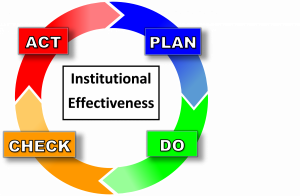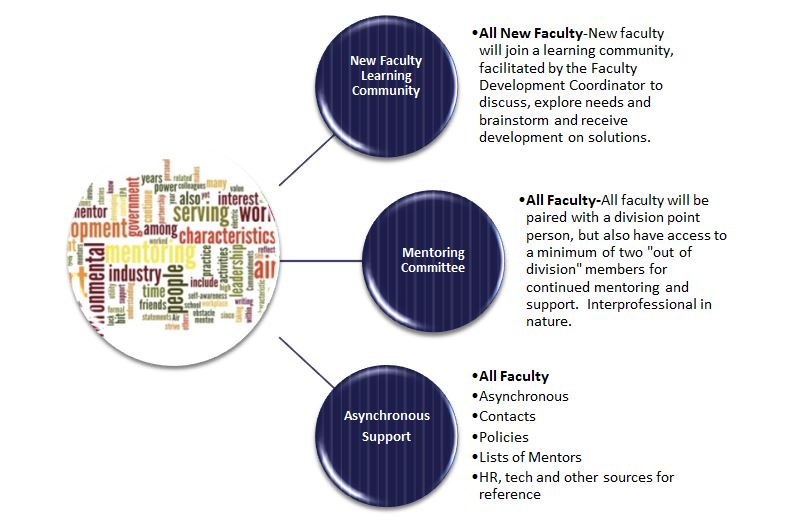Mentoring Overview
According to Smith, Calderwood, Storms, Lopez, and Colwell (2016), benefits of a faculty mentoring program can include creating a community of practice within an institution of higher education where collaboration and support are often lacking. Such communities or communities of practice can nurture relationships and offer a support system which can both increase engagement in practice, but also reduce feelings of isolation. Institutions may organize mentoring in a way that senior faculty mentor junior faculty with a goal of retention and scholarship, but a meta-analysis of studies on career benefits of mentoring also found better career outcomes, including promotions, as well as subjective outcome improvement such as job satisfaction (Allen et al., 2004). The goals of mentoring at Trocaire College, and the organization of the mentoring program at Trocaire, aim to improve both objective and subjective outcomes (retention, promotion, satisfaction, and engagement).
Structure of the Mentoring Program

The general structure of the mentoring program at Trocaire College will include specific information and guidance for new faculty, adjunct faculty and anyone needing “just in time” support for quality teaching, learning, and professional satisfaction. In this way, the Trocaire Mentoring Program may be unique and will address the needs of unique programs which may utilize more adjunct faculty, require efficient new faculty support, and those who may need support outside the traditional classroom (online, in clinical settings, etc.). The Mentoring Program will also address the continued growth and development of continuing faculty and will extend to varied interests related to professional satisfaction, including research interests, teaching strategies, publication, grant initiatives, continued education and training, etc. Finally, the Mentoring Program will use an action research model and gives all participants an opportunity to practice the “Plan, Do, Check, Act” model (based on Deming, 1986), which is reiterative and allows for continuous improvement.
Figure 3.
Plan, Do, Check, Act model (based on Deming, 1986).
In short, Trocaire College is dedicated to personalizing and differentiating the Mentor Program well beyond a traditional junior to senior faculty mentor program plan to meet program goals. The Mentor Program will consist of three supportive levels, all designed to be collaborative, supportive, ongoing, and interprofessional in nature. These include the New Faculty Learning Community, the Mentoring Committee, and Asynchronous support.

New Faculty Learning Community
The work of the New Faculty Learning Community will include monthly and “just in time” or on-demand meetings, based on themes derived from a needs analysis and/or the literature. The Coordinator of The MCDC will facilitate the planned meetings and organize themes, materials, etc. The culture of these meetings will be collaborative and The MCDC is a faculty-only space where participants can freely discuss and brainstorm.
Mentoring Committee
The work of the Mentoring Committee (pairs and group) is to offer a team of support consisting of a division-specific mentor and at least two out-of-division mentors. Again, the Coordinator of The MCDC will facilitate meetings when appropriate. Teams/pairs here may work to continue to develop based on needs.
Asynchronous Support
In addition to the above organization, it was determined that faculty would benefit from asynchronous support. The Mary Clare Center Coordinator will again develop and maintain an online, asynchronous support system housed on a specifically designed Mentoring webpage. These resources include forms for mentor teams and pairs, best practices, forms to record meetings, research on best practices, etc. This will be a “living” document which will grow and continue to be developed as needed.
Timeline of the Mentor Program
It is suggested in the literature to spend considerable effort in setting up, training, and aligning mentors and mentees for a successful mentor program (Guide to Best Practices in Faculty mentoring, n.d.). It is the goal of the Mentor Committee to use the following timeline to prepare for a full launch of the Trocaire College Mentor Program:
|
Mentoring Information for Participants
Specific help and information for mentees will be provided via The Mary Clare Development Center and the Trocaire College Mentor Web site page. Specific forms will be utilized to enhance and facilitate efficient relationships which address specific goals. Possible guiding topics will include:
- Strategies for Effective Mentoring
- Best Practices in Mentoring
- Phases of Mentoring Relationships and Timelines
- How to Avoid Problematic Mentoring Relationships
- Resources Related to Effective Mentoring
Much of this information will be housed in The Mary Clare Development Center and/or on the web site. Mentors and mentees may also have access to online spaces (i.e. Moodle) for meetings, sharing of information, etc.
Mentoring Conclusion
Offering faculty the opportunity to mentor and be mentored can have several benefits to the College, to faculty, and to students. Mentoring connects to the 2020 Strategic Plan (“Best in Class”) and supports faculty. Those who choose to mentor can support a mentee with the goal of continued professional growth and satisfaction. This will benefit the college by supporting faculty, ensuring a quality educational product, and will help to build a culture of excellence. This will in turn positively impact the student experience. Faculty will benefit, both from the collegial collaboration and support, but mentors can also learn from mentees and mentees will feel supported and valued as well. This will result in retention of high-quality faculty, which is in the best interest of the College and for students attending Trocaire. By facilitating and coordinating mentoring initiatives and relationships, the Coordinator of the Mary Clare Development Center can also gauge what support is needed for faculty development and diversify development opportunities for all faculty. A formal mentoring program will be new to Trocaire College, but in the spirit of long-term success and relevance, specifically excellence, market agility, revenue diversification, and presence and visibility (2020 Strategic Plan, 2017.), Trocaire College will aim to utilize mentoring to make a positive impact on faculty, students, leadership, and the professions.
References
2020 Strategic Plan. (2017). Trocaire College. Retrieved from https://trocaire.edu/app/uploads/2016/09/2020-Strategic-Plan-Report.pdf
Allen, T. D., Eby, L. T., Poteet, M. L., Lentz, E., & Lima, L. (2004). Career benefits associated with mentoring for protégés: A meta-analysis. Journal of Applied Psychology, 89(1), 127–136.
Guide to best practices in faculty mentoring. (n.d.). Columbia University. Retrieved from http://facultydiversity.columbia.edu/files/viceprovost/mentoring_best_practices_1.pdf
Smith, E. R., Calderwood, P. E., Storms, S. B., Lopez, P. G., & Colwell, R. P. (2016). Institutionalizing Faculty Mentoring within a Community of Practice Model. To Improve the Academy, 35(1), 35-71.
